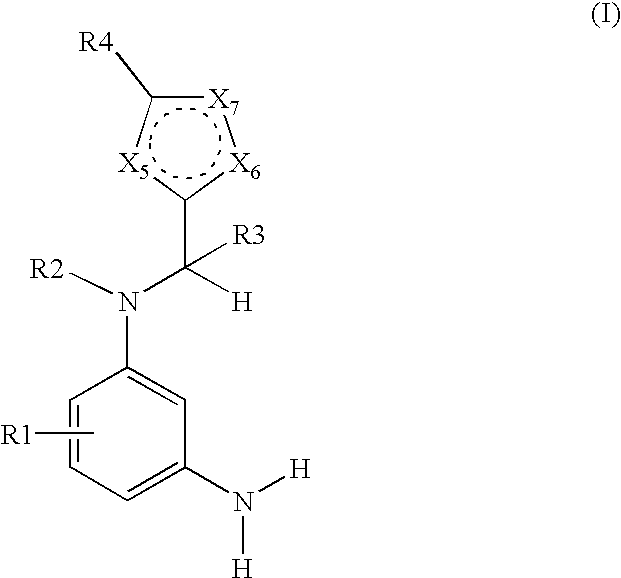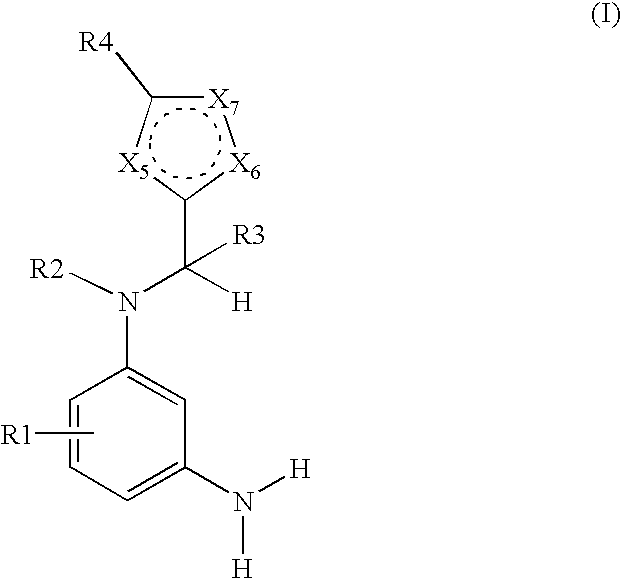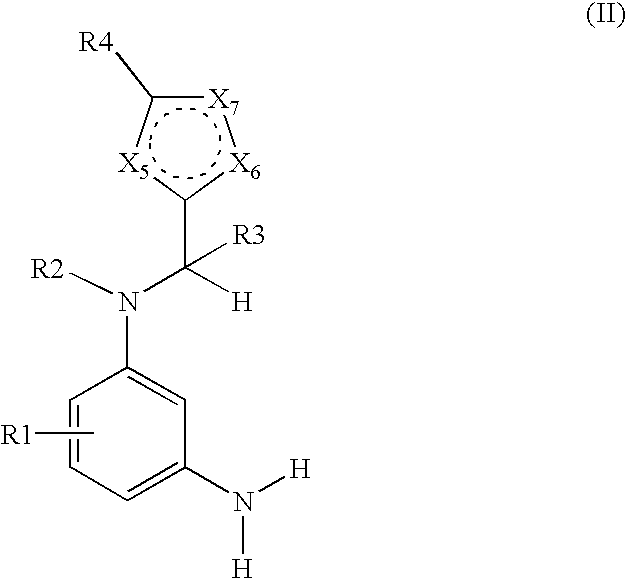N-heteroarylmethyl-m-phenylenediamine derivatives-containing dyes for keratin fibers and novel n-heteroarylmethyl-m-phenylenediamine derivatives
a technology of n-heteroarylmethyl and m-phenylenediamine, which is applied in the direction of dyeing process, hair cosmetics, organic chemistry, etc., can solve the problems of not being able to meet the requirements of dyeing agents in all respects, and achieve excellent color stability, high color intensity, and high water-soluble
- Summary
- Abstract
- Description
- Claims
- Application Information
AI Technical Summary
Benefits of technology
Problems solved by technology
Method used
Image
Examples
example 1
Synthesis of N-heteroarylmethyl-1,3-diaminobenzenes
A. Synthesis of tert.butyl (3-aminophenyl)carbamate
[0048]A solution of 11 g (50 mmol) of ditert.butyl dicarbonate in 30 mL of methylene chloride was added dropwise to a solution of 10.8 g (100 mmol) of 1,3-phenylenediamine in 100 mL of methylene chloride / NaOH (4%) 1:1. The reaction mixture was allowed to agitate 8 hours after which 5 g of ditert.butyl dicarbonate was added to it. The reaction mixture was then allowed to agitate for an additional 12 hours at room temperature. The organic phase was washed with a saturated aqueous sodium chloride solution, dried over sodium sulfate and filtered, and the filtrate was evaporated. The resulting crude product was purified on silica gel with hexane / ethyl acetate (1:1). This gave 6.2 g (30% of the theoretical) of tert.butyl (3-aminophenyl)carbamate.
[0049]1H-NMR (300 MHz, CDCl3): δ=7.06 (t, 1H); 6.99 (br s, 1H); 6.44 (br s, 2H); 6.56 (d, 1H); 6.39 (m, 2H); 3.68 (br, 2H); 1.53 (s, 9H).
B. Synth...
example 2
Synthesis of 2-{4-amino-2-[(N-heteroarylmethyl)amino]-phenoxy}ethanols
A. Synthesis of tert.butyl [3-amino-4-(2-hydroxyethoxy)phenyl]carbamate
[0065]A solution of 16.8 g of NaHCO3 in 100 mL of water was added dropwise to a solution of 10.7 g (100 mmol) of 2-(2,4-diaminophenoxy)ethanol in 300 mL of acetonitrile. Then, 22 g (100 mmol) of ditert.butyl dicarbonate was added, and the reaction mixture was allowed to agitate for 6 hours. At the end of the reaction, the reaction mixture was poured into 100 mL of dichloromethane, and the organic phase was extracted with dilute hydrochloric acid. The aqueous phase was rendered alkaline with a 2N sodium hydroxide solution [sic—Translator] and then extracted with dichloromethane. The organic phase was dried over sodium sulfate and the solvent was distilled off in a rotary evaporator. This gave 10.3 g (38% of the theoretical) of tert.butyl [3-amino-4-(2-hydroxyethoxy)phenyl]carbamate.
[0066]1H-NMR (300 MHz, CDCl3): δ=7.26 (br s, 1H); 6.95 (d, 1H); ...
examples 3 to 14
[0078]
Hair ColorantsHair colorant solutions having the following composition were prepared:1.25mmolof coupler of formula (I) as per Table 11.25mmolof developer as per Table 11.0gof potassium oleate (8% aqueous solution)1.0gof ammonia (22% aqueous solution)1.0gof ethanol0.3gof ascorbic acidto 100.0gwater
[0079]Just before use, 50 g of the foregoing coloring solution was mixed with 50 g of a 6% aqueous hydrogen peroxide solution. The mixture was then applied to bleached hair. After an exposure time of 30 min at 40° C., the hair was rinsed with water, washed with a commercial shampoo and dried. The resulting color shades are presented in Table 1.
[0080]
TABLE 1DeveloperIV.I.II.III.4,5-Diamino-1-Coupler1,4-Di2,5-Diamino-2,5-Diamino-(2′-hydroxy-Exampleof formulaamino-toluenephenylethanolethyl)pyrazoleNo.(I)benzenesulfatesulfatesulfate 3As per Ex. 1adark bluedark bluedark blueviolet 4As per Ex. 1bdark bluedark bluedark blueviolet 5As per Ex. 1cdark bluedark bluedark blueviolet 6As per Ex. 1d...
PUM
| Property | Measurement | Unit |
|---|---|---|
| Percent by mass | aaaaa | aaaaa |
| Fraction | aaaaa | aaaaa |
| Fraction | aaaaa | aaaaa |
Abstract
Description
Claims
Application Information
 Login to View More
Login to View More - R&D
- Intellectual Property
- Life Sciences
- Materials
- Tech Scout
- Unparalleled Data Quality
- Higher Quality Content
- 60% Fewer Hallucinations
Browse by: Latest US Patents, China's latest patents, Technical Efficacy Thesaurus, Application Domain, Technology Topic, Popular Technical Reports.
© 2025 PatSnap. All rights reserved.Legal|Privacy policy|Modern Slavery Act Transparency Statement|Sitemap|About US| Contact US: help@patsnap.com



